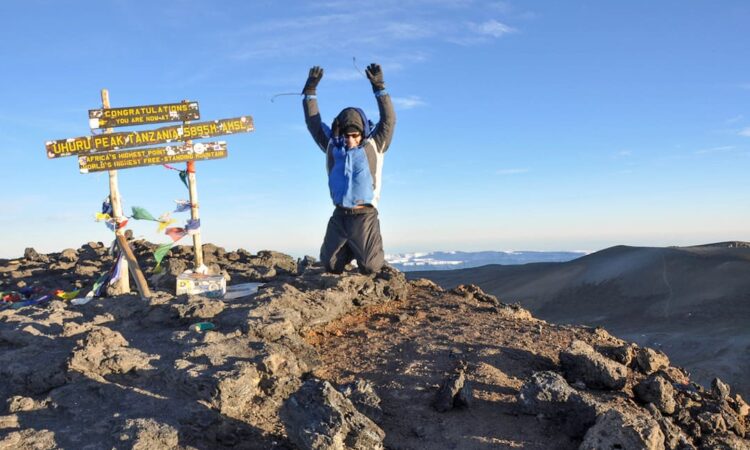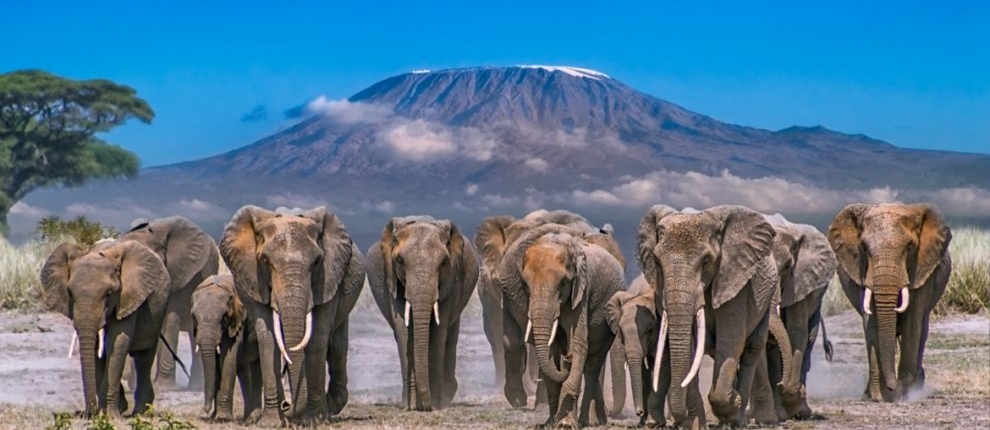Explore Mount Kilimanjaro National Park : Are you looking at visiting Mount Kilimanjaro national park? Mount Kilimanjaro National Park is located in northeastern Tanzania, is renowned for its iconic peak, Kilimanjaro which is the highest mountain in African reaching an elevation of 5,895 meters above the sea level. The national park encompassed an area of approximately 1,688 square kilometers and was established in 1973, becoming a UNESCO World Heritage Site in 1987. Mount Kilimanjaro National Park is situated near the town of Moshi, about 300 kilometers south of Nairobi in Kenya. The park’s location makes it a prime destination for tourist seeking adventure and breathtaking scenery, as it features a diverse range of ecosystem, from tropical rainforest at lower altitudes to alpine desert and glaciers at the summit.

Amazingly, Mount Kilimanjaro is one of the largest volcanoes in the world. It has three main volcanic peaks, Kibo, Mawenzi, and Shira. With its snow-capped peak and glaciers, it is the highest mountain in Africa. The mountain has five main vegetation zones from the lowest to the highest point: Lower slopes, montane forest, heath and moorland, alpine desert and summit. The whole mountain including the montane forest belt is very rich in species, in particular mammals, many of them endangered species. For this combination of features but mostly its height, its physical form and snow cap and its isolation above the surrounding plains, Mount Kilimanjaro is considered an outstanding example of a superlative natural phenomenon.
Mount Kilimanjaro National Park is home to a diverse array of wildlife although the higher elevations are not as populated with animas compared to the lush lower slopes. the wildlife varies according to the attitudes and habitat, which can be classified into several zones such as;
Rainforest zone (800-2,700 meters). The lower sloped of Kilimanjaro are cloaked in dense tropical rainforest which is rich in biodiversity. the zone s home to several species of primate including black and white colobus monkey, white-tailed mongoose, Sykes monkeys, marsh mongoose, white-necked raven, bush baby among others. Other wildlife includes elephants, buffalos, lions, leopards, Aardvark, tree hyrax, duikers, bushbucks and a variety of birds such as the black-white casqued hornbill and the great blue turaco among others.
Heather-moorland zone (2,700 -3,600 meters). Above the rainforest, the ecosystem transitions to the heather moorland which us charactered by dense vegetation including giant heather and the unique plants. In this zone, visitors might encounter animals such as agile klipspringer and various high-altitude bird species including the sunbirds and buzzards.
Alpine desert zone (3,600- 4,500 meters). The condition becomes harsher at tis elevation, with minimal vegetation and extreme temperatures. Additionally, wildlife here is sparse, but species like rock hyrax can occasionally be seen. the landscape is dominated by volcanic rocks and a few resilient species like lichens, moss and hardy succulents.
And finally, Summit zone (above 4,500 meters). At the summit, wildlife sightings are area, as the environment is characterized by extreme cold and arid conditions.
Mount Kilimanjaro also holds a great cultural significant for the local tribes including the Chaga people, the have lived on the mountain’s slopes for centuries, relying on its fertile land for agriculture and substances. The mountain is seen as a symbol of heritage and identity, and various cultural practices and traditions and tied to its presence.
What is the best time to visit Mount Kilimanjaro National Park
The best time to visit Mount Kilimanjaro national park is during the dry season, which runs from June to October, and also from December to early march. during these months, the weather is generally clear and dry, making your easier to trek and see the stunning views of the mountain.
The wet season, which occur from November to early December and from late march to may, is not ideal for climbing Kilimanjaro as the trails can become muddy and slippery, the trek more challenging and less enjoyable. Additionally, the rainy season brings an increased risk of avalanched and rockfalls, which can be dangerous for climbers.
Visiting during the dry season also offers the beat chance of clear skies and unobstructed views of the surrounding landscape. The temperatures are milder during these months, making it more comfortable for trekking and climbing on the mountain. While the dry season is the most popular time to visit Kilimanjaro national park, it is important to note that it can be crowded with other climbers. For Tanzania hiking safaris on Mount Kilimanjaro, recommended hiking gear includes gloves, sleeping bags, and trekking boots. The hikers can get help from porters and guides while they are exploring Tanzania and Mount Kilimanjaro by foot.
What are the best safari activities to do while on a Mount Kilimanjaro safari?
Kilimanjaro trekking
One of the most popular activities on a Mount Kilimanjaro safari is trekking to the summit of Africa’s highest mountain. Multiple routes including Machame, Marangu, Lemosho and Rongai routes, cater to varying fitness levels and preferences. The trek typically takes about 5 to 9 days, allowing climbers to acclimatize to the altitude while enjoying diverse ecosystems. As you ascend, you’ll experience a remarkable transition in vegetation, from lush rainforest filled with blue monkeys and vibrant birds at lower altitudes to alpine deserts dotted with unique flora, such as giant lobalias and senecios. Each day presents breathtaking views of the mountain’s summit, Uhuru peak and the expansive landscapes below.
Trekkers often camp along the route, offering a chance to connect with nature under star-studded African skies. Guided by experienced porters and guides, climbers receive support and information about the local communities and wildlife. The physical challengers of the hike, combined with the stunning scenery and sense of accomplishment upon reaching the summit, makes trekking Mount Kilimanjaro an unforgettable adventure that attracts adventures from around the world.
Wildlife watching
While Mount Kilimanjaro is popularly known for its trekking expeditions, the surrounding landscape also offered unique wildlife watching opportunities. The lower slopes of Kilimanjaro are covers with lush rainforest and verdant fields the provide habitats for a variety of species. Tourist can enjoy guided safari walks and drives in the nearby Kilimanjaro National Park and surrounding wildlife area like Amboseli National Park.

During your wildlife watching excursion in mount Kilimanjaro national park, you’ll have the opportunity to encounter with a wide range of astonishing wildlife species such as primate including black and white colobus monkey, white- tailed mongoose, Sykes monkeys, marsh mongoose, white-necked raven, bush baby , animals like elephants, buffalos, lions, leopards, Aardvark, tree hyrax, duikers, bushbucks and a variety of birds such as the black-white casqued hornbill , the great blue turaco and the crowned crane among others. Additionally, the park is home to some of the rare species including the Kilimanjaro sandwort, a plant found only in tis region.
Wildlife watching can often be combined with cultural experiences, as local guides share stories about the flora and fauna, along with their traditional relationship with the land. This immersive experience allows tourists to appreciate the delicate balance between conservation and local culture while gaining insight into the significance of wildlife in the Kilimanjaro ecosystem.
Birdwatching
Birdwatching is another rewarding activity for visitors exploring the Mount Kilimanjaro region. The diverse habitats surrounding the mountain, raging from tropical rainforests to high-altitude moorlands, provide sanctuary for an incredible variety of avian species. Mount Kilimanjaro and its adjacent areas is home to over 700 bird species, making it a paradise for bird watchers. During your birdwatching excursion in the park, you’ll have the chance to spot a verity of colorful bird species such as Silvery-Cheeked Hornbill, Trumpeter Hornbill, Emerald Cuckoo, Klaas Cuckoo, Lark-Heeled Cuckoo, white brown Coucal and many more. Kingfishers like African pygmy kingfisher, Malachite Kingfisher, bee-eaters, African Pitta, Hartlaub’s Turaco, Schalow’s Turaco, Violent Crested Turaco, Rose Turaco, sunbirds among others. Guided birdwatching excursions often lead visitors along scenic trails, where expert guides provide insight into the bird’s behaviors, call and habitats.
Cultural tours
Cultural tours in Kilimanjaro region provide a fascinating glimpse in to a rich heritage of the local communities surrounding the mountain. Tourists can interact with indigenous groups such as the Chagga people, who have historically inhabited the fertile foothills of Kilimanjaro. These tours often include visits to traditional villages where visitors can learn about the distinct customs, lifestyle and agricultural practices of the Chagga. During a cultural tour, you will have the chance to engage in different activities such as cooking classes, learning how to prepare traditional dishes using fresh ingredients. Visitors can also have to chance to explore the coffee plantations while discovering the entire process from harvesting to brewing, of one of the Tanzania’s most important commodities. You will have brewing, the opportunity to engage with the local artisans through workshop which provides ab insight inti traditional crafts such as basket weaving and beadwork among others.


